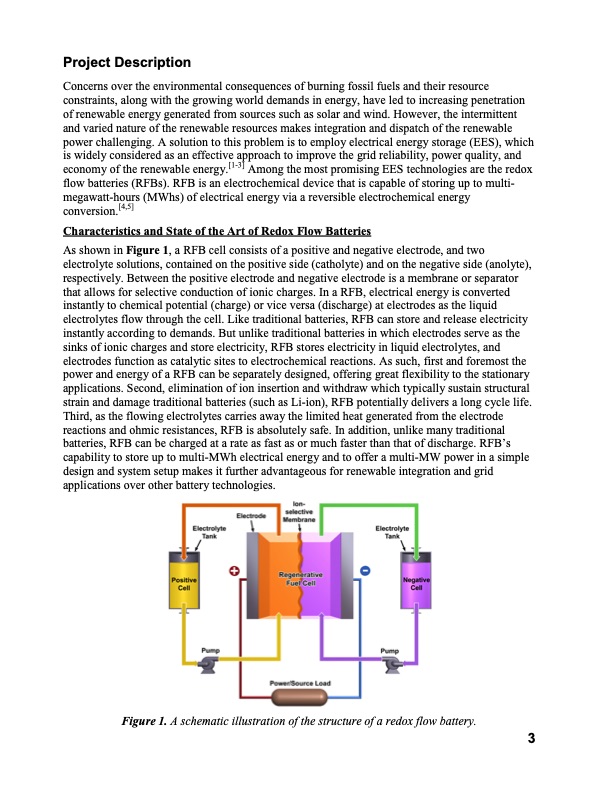
PDF Publication Title:
Text from PDF Page: 006
Project Description Concerns over the environmental consequences of burning fossil fuels and their resource constraints, along with the growing world demands in energy, have led to increasing penetration of renewable energy generated from sources such as solar and wind. However, the intermittent and varied nature of the renewable resources makes integration and dispatch of the renewable power challenging. A solution to this problem is to employ electrical energy storage (EES), which is widely considered as an effective approach to improve the grid reliability, power quality, and economy of the renewable energy.[1-3] Among the most promising EES technologies are the redox flow batteries (RFBs). RFB is an electrochemical device that is capable of storing up to multi- megawatt-hours (MWhs) of electrical energy via a reversible electrochemical energy conversion.[4,5] Characteristics and State of the Art of Redox Flow Batteries As shown in Figure 1, a RFB cell consists of a positive and negative electrode, and two electrolyte solutions, contained on the positive side (catholyte) and on the negative side (anolyte), respectively. Between the positive electrode and negative electrode is a membrane or separator that allows for selective conduction of ionic charges. In a RFB, electrical energy is converted instantly to chemical potential (charge) or vice versa (discharge) at electrodes as the liquid electrolytes flow through the cell. Like traditional batteries, RFB can store and release electricity instantly according to demands. But unlike traditional batteries in which electrodes serve as the sinks of ionic charges and store electricity, RFB stores electricity in liquid electrolytes, and electrodes function as catalytic sites to electrochemical reactions. As such, first and foremost the power and energy of a RFB can be separately designed, offering great flexibility to the stationary applications. Second, elimination of ion insertion and withdraw which typically sustain structural strain and damage traditional batteries (such as Li-ion), RFB potentially delivers a long cycle life. Third, as the flowing electrolytes carries away the limited heat generated from the electrode reactions and ohmic resistances, RFB is absolutely safe. In addition, unlike many traditional batteries, RFB can be charged at a rate as fast as or much faster than that of discharge. RFB’s capability to store up to multi-MWh electrical energy and to offer a multi-MW power in a simple design and system setup makes it further advantageous for renewable integration and grid applications over other battery technologies. Figure 1. A schematic illustration of the structure of a redox flow battery. 3PDF Image | Redox Flow Batteries for Stationary Electrical Energy Storage

PDF Search Title:
Redox Flow Batteries for Stationary Electrical Energy StorageOriginal File Name Searched:
PNNL-21174.pdfDIY PDF Search: Google It | Yahoo | Bing
Salgenx Redox Flow Battery Technology: Salt water flow battery technology with low cost and great energy density that can be used for power storage and thermal storage. Let us de-risk your production using our license. Our aqueous flow battery is less cost than Tesla Megapack and available faster. Redox flow battery. No membrane needed like with Vanadium, or Bromine. Salgenx flow battery
| CONTACT TEL: 608-238-6001 Email: greg@salgenx.com | RSS | AMP |